
The Church of the Holy Sepulchre, also known as the Church of the Resurrection, is a fourth-century church in the Christian Quarter of the Old City of Jerusalem. The church is also the seat of the Greek Orthodox Patriarchate of Jerusalem. It is considered the holiest site in Christianity and has been the most important pilgrimage site for Christians since the fourth century.
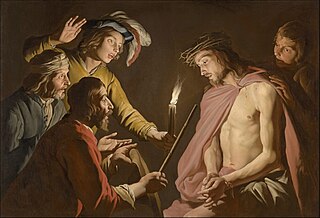
The Passion is the short final period before the death of Jesus, described in the four canonical gospels. It is commemorated in Christianity every year during Holy Week.
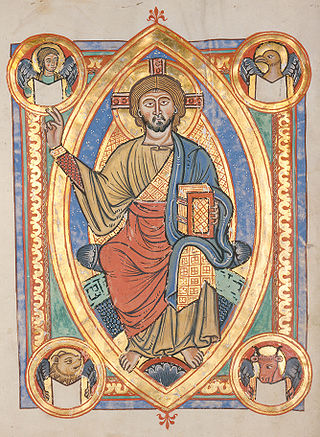
The Stations of the Cross or the Way of the Cross, also known as the Way of Sorrows or the Via Crucis, are a series of images depicting Jesus Christ on the day of his crucifixion and accompanying prayers. The stations grew out of imitations of the Via Dolorosa in Jerusalem, which is a traditional processional route symbolising the path Jesus walked to Mount Calvary. The objective of the stations is to help the Christian faithful to make a spiritual pilgrimage through contemplation of the Passion of Christ. It has become one of the most popular devotions and the stations can be found in many Western Christian churches, including those in the Roman Catholic, Lutheran, Anglican, and Methodist traditions.

Simon of Cyrene was the man compelled by the Romans to carry the cross of Jesus of Nazareth as Jesus was taken to his crucifixion, according to all three Synoptic Gospels:
And as they came out, they found a man of Cyrene, Simon by name: him they compelled to bear his cross.

Bethphage or Bethsphage, is a Christian religious site on the Mount of Olives east of historical Jerusalem.

The Via Dolorosa is a processional route in the Old City of Jerusalem. It represents the path that Jesus took, forced by the Roman soldiers, on the way to his crucifixion. The winding route from the former Antonia Fortress to the Church of the Holy Sepulchre—a distance of about 600 metres (2,000 ft)—is a celebrated place of Christian pilgrimage. The current route has been established since the 18th century, replacing various earlier versions. It is today marked by 14 Stations of the Cross, nine of which are outside, in the streets, with the remaining five stations being currently inside the Church of the Holy Sepulchre.
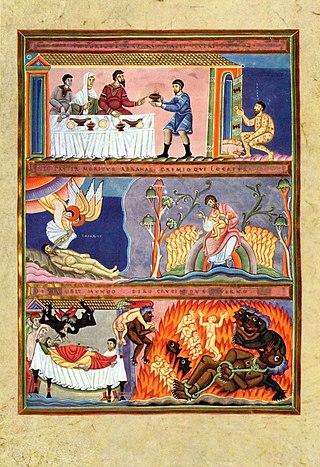
The rich man and Lazarus is a parable of Jesus from the 16th chapter of the Gospel of Luke. Speaking to his disciples and some Pharisees, Jesus tells of an unnamed rich man and a beggar named Lazarus. When both die, the rich man goes to Hades and implores Abraham to send Lazarus from his bosom to warn the rich man's family from sharing his fate. Abraham replies, "If they do not listen to Moses and the Prophets, they will not be convinced even if someone rises from the dead."
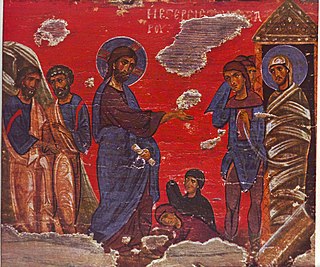
Lazarus of Bethany is a figure within the Christian Bible, mentioned in the New Testament in the Gospel of John, whose life is restored by Jesus four days after his death. This is seen by Christians as one of the miracles of Jesus. In the Eastern Orthodox Church, Lazarus is venerated as Righteous Lazarus, the Four-Days Dead. The Eastern Orthodox and Catholic traditions offer varying accounts of the later events of his life.

The Catholic Church in Israel is part of the worldwide Catholic Church, in full communion with the Holy See in Rome. The Catholic Church in Israel is divided into three main jurisdictions: the Latin Patriarchate of Jerusalem, the Franciscan Custody of the Holy Land, and the Salesian Mission. Each of these jurisdictions has its own responsibilities and areas of operation.

John 12 is the twelfth chapter of the Gospel of John in the New Testament of the Christian Bible. It narrates an anointing of Jesus' feet, attributed to Mary of Bethany, as well as an account of the triumphal entry of Jesus Christ into Jerusalem. The author of the book containing this chapter is anonymous, but early Christian tradition uniformly affirmed that John composed this Gospel.

Luke 16 is the sixteenth chapter of the Gospel of Luke in the New Testament of the Christian Bible. It records the teachings and parables of Jesus Christ, including the account of the "rich man and Lazarus". There is an "overriding concern with riches" in this chapter, although other topics are also covered. The book containing this chapter is anonymous, but early Christian tradition uniformly affirmed that Luke the Evangelist composed this Gospel as well as the Acts of the Apostles.

Bethany, locally called in Arabic Al-Eizariya or al-Aizariya, is a Palestinian town in the Jerusalem Governorate of Palestine, bordering East Jerusalem, in the West Bank. The name al-Eizariya refers to the New Testament figure Lazarus of Bethany, who according to the Gospel of John, was raised from the dead by Jesus in the town. The traditional site of the miracle, the Tomb of Lazarus, in the city is a place of pilgrimage.

Christ Carrying the Cross on his way to his crucifixion is an episode included in the Gospel of John, and a very common subject in art, especially in the fourteen Stations of the Cross, sets of which are now found in almost all Roman Catholic churches, as well as in many Lutheran churches and Anglican churches. However, the subject occurs in many other contexts, including single works and cycles of the Life of Christ or the Passion of Christ. Alternative names include the Procession to Calvary, Road to Calvary and Way to Calvary, Calvary or Golgotha being the site of the crucifixion outside Jerusalem. The actual route taken is defined by tradition as the Via Dolorosa in Jerusalem, although the specific path of this route has varied over the centuries and continues to be the subject of debate.

The Church of the Flagellation is a Roman Catholic church and Christian pilgrimage site located in the Muslim Quarter of the Old City of Jerusalem, near St. Stephen's Gate. It is part a Franciscan monastery which also includes the Church of the Condemnation and Imposition of the Cross. The monastery stands at the traditional Second Station of the Cross on the Via Dolorosa.

The Flagellation of Christ, in art sometimes known as Christ at the Column or the Scourging at the Pillar, is an episode from the Passion of Jesus as presented in the Gospels. As such, it is frequently shown in Christian art, in cycles of the Passion or the larger subject of the Life of Christ. Catholic tradition places the Flagellation on the site of the Church of the Flagellation (the second station of the Via Dolorosa in Jerusalem. It is the second Sorrowful Mystery of the Rosary and the sixth station of the John Paul II’s Scriptural Way of the Cross. The column to which Christ is normally shown to be tied, and the rope, scourge, whip or birch are elements in the Arma Christi. The Basilica di Santa Prassede in Rome is one of the churches claiming to possess the original column or parts of it.

The Tomb of Lazarus is a traditional spot of pilgrimage located in the East Jerusalem town of al-Eizariya, in Palestine, the biblical village of Bethany, on the southeast slope of the Mount of Olives, some 2.4 km east of Jerusalem. The tomb is the purported site of a miracle recorded in the Gospel of John in which Jesus raised Lazarus from the dead.
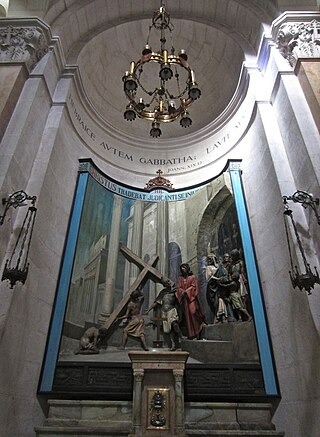
The Church of the Condemnation and Imposition of the Cross is a Roman Catholic church located within the Franciscan monastery that also contains the Church of the Flagellation in the old city of Jerusalem. The monastery stands at the traditional Second Station of the Cross on the Via Dolorosa.
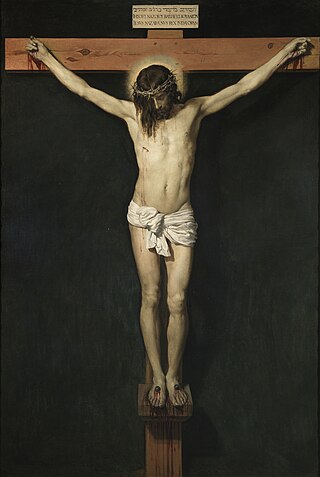
The crucifixion of Jesus was the supposed violent death of Jesus by nailing him to a wooden cross. It is considered to have happened in 1st-century Judaea, most likely in AD 30 or AD 33. It is described in the four canonical gospels, referred to in the New Testament epistles, later attested to by other ancient sources, and is broadly accepted as one of the events to have most likely occurred during his life. There is no consensus among historians on the details.

The Church of Our Lady of the Graces is a Gothic-style, Roman Catholic church in Varallo Sesia, province of Vercelli, region of Piedmont, Italy. The church was built, together with the adjacent Franciscan convent, by padre Bernardo Caimi between 1486 and 1493. At this time, the construction of the Sacro Monte was also beginning. In December 1931, Pope Pius XI gave the church the title of Minor Basilica.
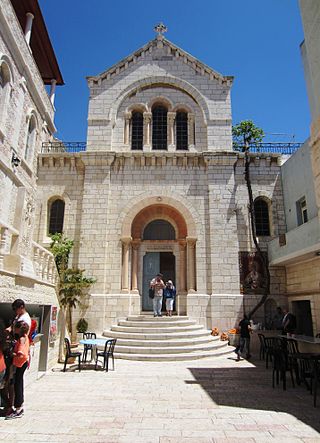
The Church of Our Lady of Sorrows, or the Church of Sorrows of Mary, also called the Armenian Chapel of Our Lady of the Spasm, is an Armenian Catholic church building in the Old City of Jerusalem erected in 1881.





















